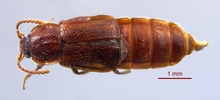Omaliinae
| Omaliinae | |
|---|---|

| |
| Acidota subcarinata | |
| Scientific classification | |
| Domain: | Eukaryota |
| Kingdom: | Animalia |
| Phylum: | Arthropoda |
| Class: | Insecta |
| Order: | Coleoptera |
| Family: | Staphylinidae |
| Subfamily: | Omaliinae MacLeay, 1825 |
The Omaliinae are a subfamily of the Staphylinidae, rove beetles.[1]
Anatomy
[edit]Typical adults are 1.5 to 6 mm long, somewhat broader in shape than are most Staphylinidae, with somewhat longer elytra (without serial punctures), the head with a broad neck, the antennae which are only slightly broader at the apex, and tarsi of five articles. In almost all genera is a pair of ocelli near the base of the head, and in a few, the elytra cover the entire abdomen. The maxillary mala of larvae are strap-shaped, but not as long as in the Proteininae, and the mandible lacks a prostheca.
-
Acidota subcarinata
-
Brathinus nitidus
-
Deinopteroloma pictum
-
Phloeonomus laesicollis
Ecology
[edit]Adults and larvae occur in leaf litter, decaying fruits, moss, and under bark of dead trees. Adults of several species and larvae of a few occur in flowers. Adults and larvae of many genera and species are believed to be predatory (they feed on freshly killed small insects), though a few seem to be phytophagous (they damage flowers) or saprophagous (they feed on decaying fruits).
Systematics and evolution
[edit]The Omaliinae subfamily is large (comprising over 100 genera), and is divided into these seven tribes:
In North America, 55 genera and more than 200 species are found.
References
[edit]- ^ Newton, A. F., Jr., M. K. Thayer, J. S. Ashe, and D. S. Chandler. 2001. 22. Staphylinidae Latreille, 1802. p. 272–418. In: R. H. Arnett, Jr., and M. C. Thomas (eds.). American beetles, Volume 1. CRC Press; Boca Raton, Florida. ix + 443 p.
External links
[edit]- Omaliinae at Bugguide.net. [1]




